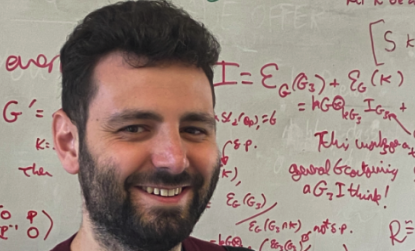The study of finitely generated groups usually proceeds in two steps. Firstly, a class of spaces with some intrinsic geometric property is defined and understood, for example hyperbolic spaces or CAT(0) spaces. Secondly, we try to relate the geometry of the space to algebraic properties of groups acting properly discontinuously cocompactly (i.e. geometrically) on the space. For example, this gives rise to the well studied classes of hyperbolic groups and CAT(0) groups.
A natural question is to understand how badly a class of groups can behave in the presence of well understood geometry. Some of my recent work has focused on the interactions of three different classes of groups:
(1) biautomatic groups;
(2) CAT(0) groups;
(3) hierarchically hyperbolic groups (HHGs).
The first class is language theoretic and relates a group to a finite state automata. The other two classes are directly related to non-positive curvature. For instance CAT(0) groups are a combinatorial/metric generalisation of the fundamental groups non-positively curved Riemannian manifolds. HHGs, on the other hand, are the groups acting geometrically on a hierarchically hyperbolic space (HHS). An HHS can very informally be thought of as a space with coordinate system parametrised by (a hierarchy) of hyperbolic spaces. The reader may be interested in the relationships between these classes. It is known that not all biautomatic groups are CAT(0) (see [NR97]) or an HHG (see [PS22]). Similarly, it is known that not all HHGs are CAT(0) (e.g. mapping class groups) and not all CAT(0) groups are HHGs (see [PS22]). Finally, due to recent work of Leary--Minasyan it is known that not all CAT(0) groups are biautomatic [LM21]. The final relation: "is every HHG biautomatic?'' will be returned to below.
To study CAT(0) groups I introduced the notion of a graph or complex of lattices [Hug21a]. Roughly this gives a method to glue together well understood CAT(0) groups acting on a fixed CAT(0) space $X$ to obtain more complicated ones - usually acting on a product space $X\times Y$. The converse is also, in a sense true, if $Y$ is a CAT(0) polyhedral complex then every CAT(0) group acting geometrically on a product $X\times Y$ splits as a complex of lattices.
Using this machinery I have found a number of applications:
(1) Non-virtually torsion-free lattices in a product of trees
A group $\Gamma$ is virtually torsion-free if there is a finite index subgroup $\Lambda$ of $\Gamma$ such that every non-trivial element of $\Lambda$ has infinite order. It is a well known open question if every hyperbolic group is virtually torsion-free. In [Hug21b] I constructed the first example of a group $\Gamma$ acting geometrically on a product of trees such that $\Gamma$ is not virtually torsion-free. I also prove that although $\Gamma$ is not a hyperbolic group, it is an HHG; this answers the analogous question, whether every HHG is virtually torsion-free, in the negative.
(2) Irreducible lattices fibring over the circle.
A group $\Gamma$ is irreducible if it does not have a finite index subgroup splitting as the direct product of two infinite groups. In [Hug22] I constructed the first example of an irreducible CAT(0) group $\Gamma$ acting on a non-trivial product such that $\Gamma$ is fibred over the circle. Here this means there is a short exact sequence $K\rightarrowtail\Gamma\twoheadrightarrow\mathbb{Z}$ such that $K$ has a finite Eilenberg-Maclane space. This hangs in sharp contrast to the case of irreducible lattices in semisimple Lie groups where the lattices do not even admit a homomorphism onto $\mathbb{Z}$.
(3) Hierarchically hyperbolic groups are not biautomatic.
In joint work with Dr. Motiejus Valiunas (Instytut Matematyczny, Universytet Wrocławski) we constructed the first example of an HHG which is not biautomatic [HV22]. The group is also CAT(0) and so gives further examples of CAT(0) groups which are not biautomatic. In particular, the three classes of groups described above are completely distinct. The geometry giving rise to the group is deceptively simple being isometric to the product of a hyperbolic place and a $24$-regular tree. Our methods, however, require us to use the space of geodesic currents for a Riemann surface.
Sam Hughes is a Postdoctoral Research Associate in the Mathematical Institute, University of Oxford.
References:
[Hug21a] Sam Hughes. Graphs and complexes of lattices. 2021. arXiv: 2104. 13728 [math.GR].
[Hug21b] Sam Hughes. Lattices in a product of trees, hierarchically hyperbolic groups, and virtual torsion-freeness. To appear in: Bull. London Math. Soc. (2021). arXiv: 2105.02847 [math.GR].
[Hug22] Sam Hughes. Irreducible lattices fibring over the circle. 2022. arXiv: 2201.06525 [math.GR].
[HV22] Sam Hughes and Motiejus Valiunas. Commensurating HNN-extensions: hierarchical hyperbolicity and biautomaticity. 2022. arXiv: 2203. 11996 [math.GR].
[LM21] Ian J. Leary and Ashot Minasyan. Commensurating HNN extensions: nonpositive curvature and biautomaticity. In: Geom. Topol. 25.4 (2021), pp. 1819–1860. doi: 10.2140/gt.2021.25. 1819.
[NR97] Walter D. Neumann and Lawrence Reeves. Central extensions of word hyperbolic groups. In: Ann. of Math. (2) 145.1 (1997), pp. 183–192. doi: 10.2307/2951827.
[PS22] Harry Petyt and Davide Spriano. Unbounded domains in hierarchically hyperbolic groups. To appear in: Groups Geom. Dyn. (2022). arXiv: 2007.12535 [math.GR].


